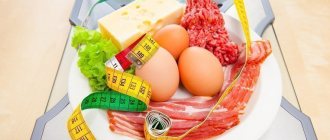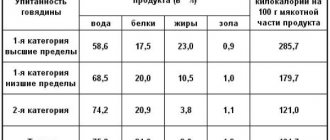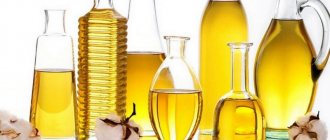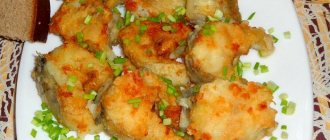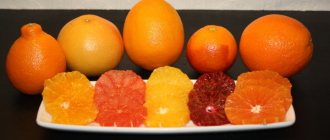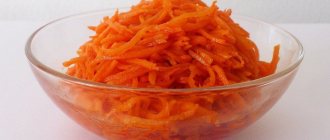Carbohydrates or proteins?
Since childhood, we have been told that we must eat porridge for breakfast, otherwise “we won’t have the strength.” Nutritionist Alena Vozhakova explains that this is a big misconception.
When you eat fast carbohydrates in the morning (sweet cereals from white cereals, muesli, baked goods, etc.), your blood sugar level quickly rises, and you really feel energetic. But at exactly the same speed the opposite reaction occurs, a feeling of even greater fatigue and hunger comes. Such insulin surges lead to weight gain and the development of diabetes.
If breakfast consists of proteins, fats and slow carbohydrates, then the blood sugar level gradually rises within normal limits and slowly falls. You remain productive for a long time. And a repeated feeling of hunger occurs already at lunchtime, which is physiological and correct.
About the amount of carbohydrates
How do you know how much carbohydrate is enough for normal metabolism?
When creating your daily menu, try to adhere to a rational ratio of nutrients: fats/proteins/carbohydrates: 1:3:4 or 1:3:5. (If you are a supporter of calculating everything or use special diet calculators according to BZHUK, then the following visual calculation will help you. For example, in the process of losing weight with a calorie diet of 1200-1500 kcal, the ratio of nutrients in grams can be maintained as follows: 30-40 g of fat, 80 -120 g protein, 150-165 g carbohydrates).
In this case, it is necessary to adhere to two basic rules regarding the consumption of carbohydrates:
1) Carbohydrate-containing foods should be eaten in the first half of the day - for first breakfast, second breakfast (snack) and for lunch (for example, a buckwheat dish), if lunch is no later than 13.00. After lunch, for an afternoon snack and dinner, only vegetables, except potatoes, are allowed from carbohydrate-containing foods. This is due to the fact that in the first half of the day the metabolism is faster, and carbohydrates (if they are not consumed in a very large portion) are completely processed by the body into energy, and are not stored in fat reserves.
2) Carbohydrates are divided into fast and slow (read more about these types of carbohydrates here). When losing weight, you need to eat mainly slow carbohydrates, and reduce fast carbohydrates to a minimum (leaving only fruits in reasonable quantities from fast carbohydrates in the diet, as they are rich in vitamins and minerals).
We've dealt with carbohydrates. Now let's move on to the second “enemy” of those losing weight - fats.
The purpose of breakfast is to fill you up
In the early 1950s in England, a breakfast consisting of scrambled eggs, bacon and beans became very popular among the working class. It was proteins and fats that gave workers the necessary boost of energy and a long-lasting feeling of fullness. This is confirmed by modern research.
A scientific article was published in the journal Nutrients in 2021 that examined the difference between eating eggs and oatmeal for breakfast. The experiment found that participants who ate eggs every morning felt fuller longer than those who ate oatmeal. It was also found that eating protein for breakfast reduces the amount of ghrelin in the blood.
Ghrelin
is a hormone that stimulates hunger and often makes you want to eat something you don't need. When your levels remain low, you lose weight faster and find it easier to maintain weight.
And another study found that athletes who ate a low-carb, high-fat diet had improved endurance performance.
Photo: istockphoto.com
The effectiveness of diets: research
The researchers recruited 21 participants whose BMI was greater than 25 to lose weight over an 8-week period. All participants had at least 3 months of strength training experience, and they also performed strength exercises during the entire experiment. 12 of the participants tried to lose weight by switching to a low-carb diet. For the first four weeks of the experiment, they were given 30g of carbohydrates daily, after which they were allowed to increase their carbohydrate intake by 10g each week, gradually increasing their carbohydrate intake to 70g over the remaining month. However, these experiment participants did not count the total number of calories consumed. Another group followed a traditional low-calorie diet to lose weight and counted calories. These participants created an energy deficit by consuming 30 percent less energy than they expended. Energy was obtained 15 percent from protein, 30 percent from fat and 55 percent from carbohydrates.
Proteins fats carbohydrates. Reference
1. The main building material in the body. 2. They are carriers of vitamins, hormones, fatty acids and other substances. 3. Ensure the normal functioning of the immune system. 4. Provide the state of the “heredity apparatus”. 5. They are catalysts for all biochemical metabolic reactions of the body.
The human body under normal conditions (in conditions when there is no need to replenish amino acid deficiency due to the breakdown of serum and cellular proteins) is practically deprived of protein reserves (reserve - 45 g : 40 g in muscles, 5 g in blood and liver), therefore the only source of replenishment is The fund of amino acids from which the body's proteins are synthesized can only serve as food proteins.
Regardless of species specificity, all diverse protein structures contain only 20 amino acids.
There are nonessential amino acids (synthesized in the body) and essential amino acids (cannot be synthesized in the body, and therefore must be supplied to the body in food). Essential amino acids include: valine, isoleucine, leucine, lysine, methionine, threonine, tryptophan, phenylalanine.
A lack of essential amino acids in food leads to disturbances in protein metabolism.
Essential amino acids are valine, leucine, isoleucine, threonine, methionine, phenylalanine, tryptophan, cysteine, and conditionally essential amino acids are arginine and histidine. A person receives all these amino acids only from food.
Nonessential amino acids are also necessary for human life, but they can also be synthesized in the body itself from metabolic products of carbohydrates and lipids. These include glycocol, alanine, cysteine, glutamic and aspartic acids, tyrosine, proline, serine, glycine; conditionally replaceable - arginine and histidine.
Proteins containing a full set of essential amino acids are called complete and have maximum biological value (meat, fish, eggs, caviar, milk, mushrooms, potatoes).
Proteins that do not contain at least one essential amino acid or if they are contained in insufficient quantities are called incomplete (vegetable proteins). In this regard, to meet the need for amino acids, the most rational is a varied diet with a predominance of animal proteins.
In addition to the main function of proteins - proteins as plastic materials - they can also be used as a source of energy when there is a lack of other substances (carbohydrates and fats). When 1 g of protein is oxidized, about 4.1 kcal is released.
When there is an excess intake of proteins in the body, exceeding the need, they can be converted into carbohydrates and fats. Excessive protein consumption causes overload of the liver and kidneys, which are involved in the neutralization and elimination of their metabolites. The risk of allergic reactions increases. The processes of putrefaction in the intestines intensify - indigestion in the intestines.
Protein deficiency in food leads to the phenomena of protein starvation - exhaustion, dystrophy of internal organs, hunger edema, apathy, decreased resistance of the body to the action of damaging environmental factors, muscle weakness, dysfunction of the central and peripheral nervous system, disruption of the central nervous system, impaired development of children.
The daily protein requirement is 1 g/kg of weight, provided there is a sufficient content of essential amino acids (for example, when taking about 30 g of animal protein), old people and children - 1.2-1.5 g/kg , with hard work, muscle growth - 2 g/kg .
FATS (lipids) are organic compounds consisting of glycerol and fatty acids.
Functions of fats in the body:
• are the most important source of energy. When 1 g of a substance is oxidized, the maximum amount of energy is released compared to the oxidation of proteins and carbohydrates. Due to the oxidation of neutral fats, 50% of all energy in the body is formed;
• are a component of the structural elements of the cell - nucleus, cytoplasm, membrane;
• deposited in the subcutaneous tissue, protect the body from heat loss, and the surrounding internal organs from mechanical damage.
There are neutral fats (triacylglycerols), phospholipids , steroids (cholesterol).
Neutral fats received from food are broken down in the intestines into glycerol and fatty acids. These substances are absorbed - pass through the wall of the small intestine, turn back into fat and enter the lymph and blood. Blood transports fats to tissues, where they are used as energy and plastic material. Lipids are part of cellular structures.
The level of fatty acids in the body is regulated both by their deposition (storage) in adipose tissue and by their release from it. As blood glucose levels increase, fatty acids, under the influence of insulin, are deposited in adipose tissue.
The release of fatty acids from adipose tissue is stimulated by adrenaline, glucagon and somatotropic hormone, and inhibited by insulin.
Fats, as an energy material, are used mainly when performing long-term physical work of moderate and medium intensity (work in the aerobic performance mode of the body). At the beginning of muscle activity, predominantly carbohydrates are used, but as their reserves decrease, fat oxidation begins.
Lipid metabolism is closely related to the metabolism of proteins and carbohydrates. Carbohydrates and proteins entering the body in excess are converted into fat. During fasting, fats, when broken down, serve as a source of carbohydrates.
The daily requirement for fat is 25-30% of total calories. The daily requirement of essential fatty acids is about 10 g .
Fatty acids are the main products of lipid hydrolysis in the intestine. Bile and diet play a major role in the absorption of fatty acids.
Essential fatty acids that are not synthesized by the body include oleic, linoleic, linolenic and arachidic acids (daily requirement 10–12 g ).
Linoleic and lonolenic acids are found in vegetable fats, while arachidic acid is found only in animal fats.
A lack of essential fatty acids leads to impaired kidney function, skin disorders, cell damage, and metabolic disorders. An excess of essential fatty acids leads to an increased need for tocopherol (vitamin E).
CARBOHYDRATES are organic compounds found in all tissues of the body in free form in combination with lipids and proteins and are the main sources of energy.
Functions of carbohydrates in the body:
• They are a direct source of energy for the body.
• Participate in plastic metabolic processes.
• They are part of protoplasm, subcellular and cellular structures, and perform a supporting function for cells.
Carbohydrates are divided into 3 main classes: monosaccharides, disaccharides and polysaccharides.
Monosaccharides are carbohydrates that cannot be broken down into simpler forms (glucose, fructose).
Disaccharides are carbohydrates that, upon hydrolysis, yield two molecules of monosaccharides (sucrose, lactose).
Polysaccharides are carbohydrates that, when hydrolyzed, yield more than six molecules of monosaccharides (starch, glycogen, fiber).
Carbohydrates should account for up to 50–60% of the energy value of the diet.
In the digestive tract, polysaccharides (starch, glycogen; fiber and pectin are not digested in the intestine) and disaccharides, under the influence of enzymes, are broken down into monosaccharides (glucose and fructose), which are absorbed into the blood in the small intestine. A significant portion of monosaccharides enters the liver and muscles and serves as material for the formation of glycogen.
In the liver and muscles, glycogen is stored in reserve. As needed, glycogen is mobilized from the depot and converted into glucose, which enters the tissues and is used by them in the process of life.
The glycogen content in the liver is 150–200 g .
The breakdown products of proteins and fats can be partially converted into glycogen in the liver. Excessive amounts of carbohydrates turn into fat and are deposited in the fat “depot”.
About 70% of food carbohydrates are oxidized in tissues to water and carbon dioxide.
Carbohydrates are used by the body either as a direct source of heat (glucose-6-phosphate) or as an energy reserve (glycogen); Basic carbohydrates - sugars, starch, fiber - are found in plant foods, the daily requirement for which in humans is about 500 g (minimum requirement 100-150 g / day ).
With insufficiency of carbohydrates, weight loss, decreased ability to work, metabolic disorders, and intoxication of the body develop. Excess consumption of carbohydrates can lead to obesity, the development of fermentation processes in the intestines, increased allergenicity of the body, and diabetes mellitus.
The material was prepared based on information from open sources
Calories created by fat consumption
It's a completely different picture if you get your calories from fat.
Even from regular oil. Fats, in principle, are absorbed longer and more difficult. It takes a lot of digestive enzymes and time to break them down. And if you lack enzymes or have low stomach acidity, it will be even more difficult for you to fully absorb them. That is, the likelihood of assimilation of fats and all their caloric content is generally in question.
In addition, the body needs fats in the diet for many other purposes: building cells, producing hormones, producing cholesterol (and we need it vitally!)... When our body receives something, it cares primarily about ensuring the most important processes in survival . And if the body needs (and it does) to produce hormones and protect cells, but it doesn’t have enough fat, then it won’t care about your fatigue or providing you with energy. It will first take care of the main thing - the construction of new cells and the production of hormones. And only then, everything that remains from the incoming fats will be used to provide energy.
That is why there is a high probability that if you received 100 kilocalories from fats, then you may not have enough energy from them at all. For example, you “ate” 100 kilocalories, but your body took 60 from you to build everything it needed there. In the end, you only have 40 left! That is, you have a lack of calories in your diet. It is on this principle that a fatty diet is based, when a person almost completely excludes carbohydrates (but not completely, as in the Kremlin diet or the Dukan diet ), but at the same time, the fat content of his diet is off the scale even in the eyes of a fat lover like me. I promise to write more about this diet in the near future.
Yes, it’s over, if you have too much of anything, be it fats, even carbohydrates, even protein, all of this will invariably be deposited in the form of fat reserves. But, as can be seen from the example, the likelihood of gaining weight from fats is several times less than from carbohydrate foods.
Insulin responds not to what we eat, but to the total amount of energy received
Which macronutrient produces the insulin response? The answer is most often: “Sugar!” (in the sense of carbohydrates). Yes, indeed, the highest and fastest insulin response occurs to carbohydrates.
However, we also know that an insulin response also occurs to protein intake. This is one of the reasons why many followers of the ketogenic diet are afraid to overeat protein (not justified, perhaps I’ll write more later)).
And here's the news! (although it turns out that she is already quite many years old)
Experts say that the insulin response also occurs when eating fat! Fat as a source of energy. But we don’t see it because we measure insulin levels only within a few hours after eating.
According to their estimates, this answer comes later - simply because the breakdown of fats begins later.
Late breakdown of fat is a consequence of the so-called oxidative priority of the body (also a very important topic).
First of all, we break down what we cannot store. Like with ice cream: it will quickly melt in the heat if you don’t eat it right away.
Protein has the first priority for breakdown of the three main macroelements; its storage is minimal; excess must be excreted by the kidneys.
The insulin response to protein allows the body to use the resulting amino acids for actual purposes - as building material or for other metabolic functions. Another good illustration of the role of insulin as an energy manager.
Carbohydrates are the next in line to be burned; we can store them in the form of glycogen in the liver and muscles. Burning carbohydrates does not require large energy resources, so our response to carbohydrates is high and fast.
Fats are the last to be broken down, since we can store them in unlimited quantities (a sad fact in modern life). Therefore, the insulin response comes later.
Here's what one of the researchers says: “If we were to look at insulin secretion in response to food intake over a 24-hour period, we would most likely see that it is proportional to the total amount of energy we received from food, rather than the volume just one of the macronutrients.”
A researcher I highly respect, Chris Masterjohn, talks about this with all the details at the level of biochemistry for the most inquisitive.
Bottom line: Yes, the strength and timing of the insulin response differs, but all three macronutrients, including fat, lead to an insulin response!
How proteins and fats affect calorie intake
Calorie parameter (I hate this word because it's confusing, but oh well...) So, the calories from the bun will be absorbed very quickly, and the body will have almost no work to get them. After all, why is bread so tasty? Because even if it is baked without adding sugar, the sugar molecules from it are broken down under the influence of saliva. That's why bread has such a sweet taste, and it's so hard to give it up.
But if we take nuts, then in order to get calories from them, we need to expend a decent amount of energy. Therefore, if nuts, for example, contain 500 kilocalories, and we need 200 to break them down, then the calorie content is already reduced to 300. Do you see where I’m going with this?
Exactly! Calories are different.
Absorption of calories: the bun, rest assured, will be completely broken down and will be used to cover energy costs. But at least 10% of the nuts will come out of you along with everything else. Or even more - it depends on your digestion and the quality of its work. Therefore, if you eat 30 grams of nuts, then a maximum of 23 grams will be absorbed. As a result, the calorie content of the diet from nuts in the sense of “eaten and burned” is rapidly decreasing.
“Ha!”, you say. “It’s just nuts! But butter, for example, does not contain fiber and nothing will remain from it in the toilet. And its calorie content is absolutely insane...” So let’s go further to dissect this myth about fats.
For example, you need 100 kilocalories to cover your energy costs, and you decide to eat a bun or porridge. Calories from carbohydrates can only go to two places:
- Enters cells in the form of glucose
- They are stored as fat.
This is because glucose cannot be used for anything else. And if, for example, you have insulin resistance , then for this reason glucose cannot be completely absorbed by the cells. And if she didn’t go into the cages, then she has nowhere better to go than to settle on your sides and other slender curves of your body. And if the bun contained not exactly 100 kilocalories, but 125, then these extra 25 will settle on the sides of even the healthiest person, whose insulin works like a charm.
How to restore metabolism and return weight and insulin to normal
That is, it is not enough to remove sugar and carbohydrates - you need a sustainable energy deficit, which will reduce overall energy reserves.
A very striking example of the insulin response to fat was the recent experiment of famous keto blogger Jimmy Moore, who in JUST 7 DAYS of a high-protein diet with an energy deficit lowered insulin levels by 7 units.
AND!!! After just one day of actively eating fat bombs, his insulin levels returned to their previous levels.
A low-carb or ketogenic diet is a great start to optimizing carbohydrate metabolism.
Many have learned through painful experience that simply going on lchf or keto is not a solution to the problem of excess weight and insulin resistance.
Yes, reducing sugar and carbohydrates is a good strategy for restoring metabolism and hormonal regulation of hunger and satiety. However, for many it is effective only at the first stage - optimizing carbohydrate metabolism.
Calorie intake in our lives
When my friend, whom I started talking about, is visiting me, I see how she looks with poorly concealed horror at my preparation of vegetable salads, where I pour olive oil with a generous hand. At the same time, she knows that I am a nutritionist. I eat a lot and enjoy it, but at the same time I am much slimmer and healthier than she is. Although, even in fitness, she is ahead of the rest, and I definitely can’t keep up with her. Zumba, step, exercise bike, strength training... She once tried to ask me how she should eat in order to lose weight, but the advice to add fats to her diet scared her so much that she doesn’t ask me about anything like that anymore. It's been two years now. True, her weight is growing and growing...
Fats got a bad rap many years ago.
At first there were people who claimed that a person, just like a machine, consumes energy from food and burns it. Then a man appeared who not only decided to denigrate fats, but came up with a theory (by the way, still not really confirmed) about the dangers of animal fats . In general, let's be honest, fats got a real hard time.
If you find women's magazines even from five years ago, you will find that they are full of advice on how to reduce the calorie content of any dish. At the same time, the most “effective” tool for optimizing caloric intake in these tips is reducing fat. Skinless chicken and bluish, tasteless chicken breast, teaspoons of butter for a decent portion of food, or just lemon juice instead of dressing - all this comes from there. And maybe it’s just me who is surprised, but, my dears, this approach is a thing of the past.
But how difficult it is to convince people who have avoided fat for years. I even recorded a short video about daily fat intake, watch:
Just the other day I spoke with a client who claimed that she is not at all afraid of fats and does not avoid them. But when we began to select options for snacks and breakfasts for her, she carefully asked: “And if I eat 15 nuts for breakfast, does that mean I can’t have nuts for a snack that day? After all, they are so high in calories.” Answer: it is possible and necessary. Let me explain why.
Calories are different. I wrote about this in detail here. Today let's compare fats with carbohydrates. For example, let's take a bun (any bun, even a healthy whole grain one) and nuts.
